Contributory members are able to log private notes and comments about each site
Sites Anne T has logged. View this log as a table or view the most recent logs from everyone
Glendaruel Churchyard
Trip No.48 Entry No.2 Date Added: 4th Oct 2017
Site Type: Sculptured Stone
Country: Scotland (Cowal)
Visited: Yes on 21st Sep 2017. My rating: Condition 3 Ambience 4 Access 4
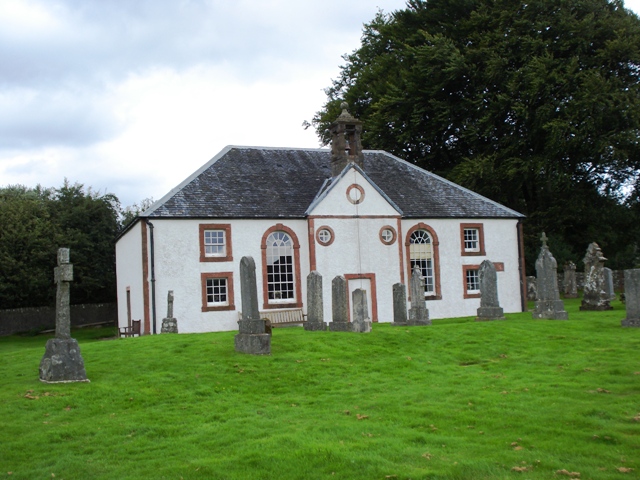
Glendaruel Churchyard submitted by Ghriogair on 21st Jul 2009. Glendaruel Church
(View photo, vote or add a comment)
Log Text: Kilmodan Stones, Glenaruel: Also known as Clacahn of Glendaruel and the Kilmodan Stones
Our second visit of the day, and another lovely spot by the River Ruel. We parked by the now deserted (almost derelict) hotel in Kilmodan village, and walked down towards the church, which is Georgian and very Church of Scotland inside.
The Lapidarium is situated to the south west of the churchyard, nearer to the river. The church guide leaflet says that the Lapidarium was formerly the mausoleum of the Campbells of Auchenbreck, roofed in as a Lapidarium. In 1970, the stones were moved from the graveyard into this building.
“The stones are 14th and 15th century and are of the Loch Awe school of carvers. The stone is schistose and the quality of the stone suggests if would have come from local quarries. In comparison to the other West Highland schools the workmanship is clumsy. In addition, the Loch Awe slabs were never inscribed. So we do not know the names of the patrons commemorated. There are 11 stones in the Lapidarium with number 6 being renowned as the finest example of the Loch Awe School. Stone 11 is the grave slab of Donald McCloy who was minister in Kilmodan from 1609 to 1636.
The bright light streaming into the Lapidarium made at this time of the afternoon made it difficult to photograph the stones properly, despite Andrew trying to block the light out, and me kneeling on the floor to avoid the direct sunlight.
There is a cup and ring marked rock mentioned on the map near to the hotel, although we were unable to find it.
Balliemore (Craigendive)
Trip No.48 Entry No.1 Date Added: 4th Oct 2017
Site Type: Standing Stones
Country: Scotland (Cowal)
Visited: Yes on 21st Sep 2017. My rating: Condition 3 Ambience 4 Access 4
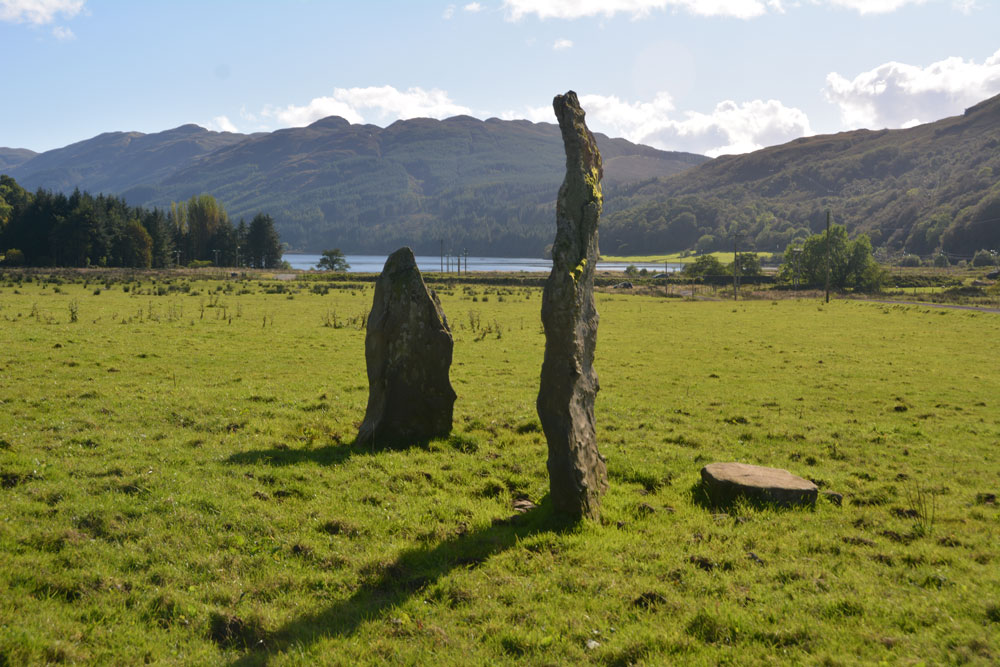
Balliemore (Craigendive) submitted by Anne T on 4th Oct 2017. Standing to the north of these two stones, looking south to the head of Loch Striven. A glorious location.
(View photo, vote or add a comment)
Log Text: Ballimore Standing Stones, West of Dunoon: To escape the rain in Armadale, we decided to take the ferry from Gourock to Dunoon. We stopped off in Dunoon for a cup of tea and a sandwich at The Tudor Coffee Shop above Thornton’s on the main high street, then we set off into the countryside, taking the B836 to Craigendive, past Loch Tarsan.
I spotted these on the map and as they were not very far off the beaten track, decided to stop off and find them. These two stones were in one of the loveliest places, just off the B836 (essentially a single-track road with passing places), to the north of Loch Striven. Surrounded by hills on three sides, on a lush, level grassy plain, with Loch Striven to the south, these standing stones lie immediately south of Balliemore Farm. We parked at NS 05511 84269, next to a pile of road gravel and stones, and walked up the track towards the farm.
There is one tall, narrow stone, and a shorter, triangular one, with a third slab lying at the base of the taller one. Packing stones can be seen in the grass.
The field was very, very wet, and we had to jump over the pools of water at the edge, particularly around the telegraph poles. A pair of wellies would have come in extremely handy!
Ancrum Old Church
Trip No.47 Entry No.3 Date Added: 3rd Oct 2017
Site Type: Sculptured Stone
Country: Scotland (Scottish Borders)
Visited: Yes on 20th Sep 2017. My rating: Condition 3 Ambience 5 Access 4
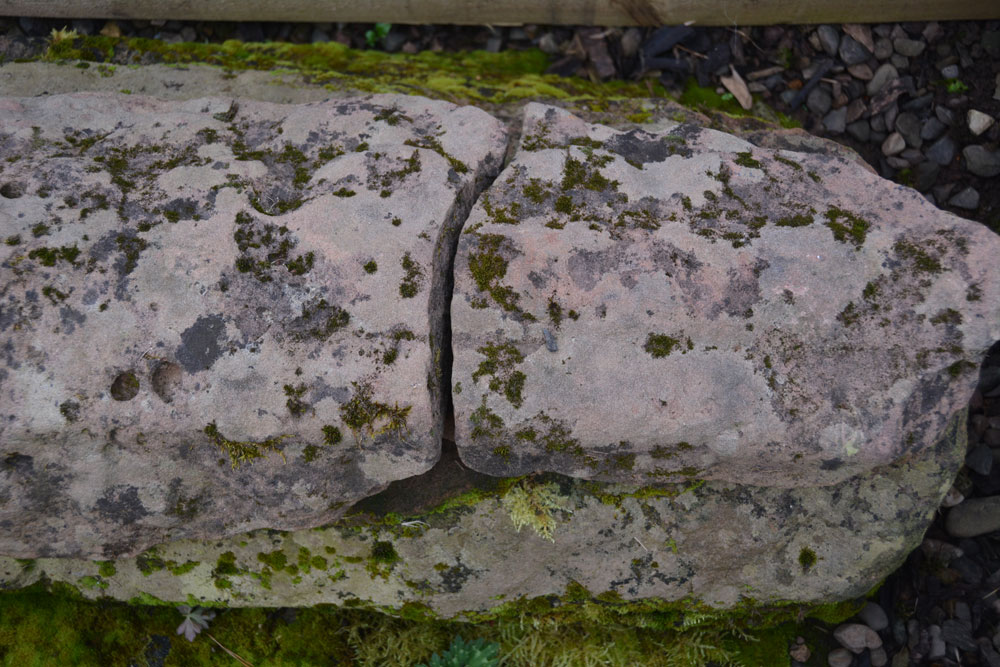
Ancrum Old Church submitted by Anne T on 3rd Oct 2017. A close up of the end of the hogback, trying to see if the camera would pick up any of the relief carving still left on the stone - sadly, no.
(View photo, vote or add a comment)
Log Text: Ancrum Old Church, Scottish Borders: This is a very beautiful location, just to the west of Ale Water and north of the B6400, west of the village of Ancrum. There is parking for 3-4 cars at the south western end of the church yard. A gate and steps lead down into the church yard; the ruined church stands at the northern end of the graveyard.
We walked all around the church, at first unsure of where to look. In the end, by holding my mobile above my head, I managed to get the Canmore record up, so we knew exactly where to look.
Ancrum 1 and 2 are within the village, within private grounds. We did spot the two inscribed slabs, a hogback and a cross base. There was a young man flying a drone all around the church and churchyard, and his dog kept following us. I tried to engage him in conversation, but only got that he was making a film for ‘his own purposes’.
We wandered over the old pack horse bridge to the eastern side of Ale Water, but this was a building site. We could see the western end of Castle Hill hillfort. By this time, it was getting late and the climb looked steep, so we bottled out of the climb, stopping off to look at Ancrum Market Cross on the way to Armadale.
Haughhead Kip (Eckford)
Trip No.47 Entry No.2 Date Added: 3rd Oct 2017
Site Type: Sculptured Stone
Country: Scotland (Scottish Borders)
Visited: Yes on 20th Sep 2017. My rating: Condition 3 Ambience 4 Access 4
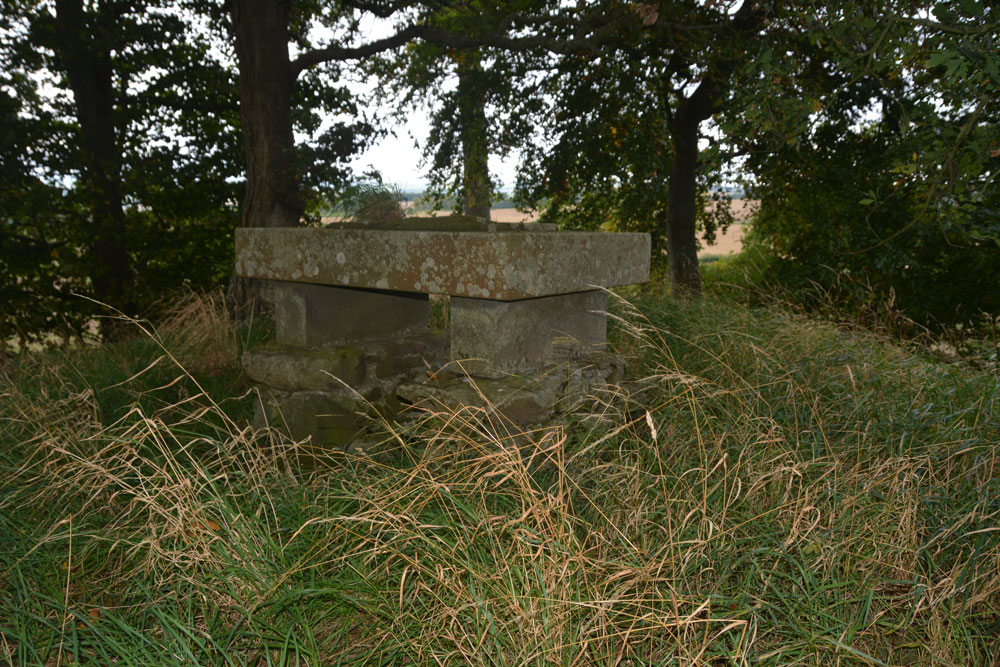
Haughhead Kip (Eckford) submitted by Anne T on 3rd Oct 2017. First view of the 'altar' with the inscribed stone on top, sited on top of the mound/tumulus.
(View photo, vote or add a comment)
Log Text: Haughhead Kip Tumulus & Inscribed Stone, Scottish Borders: This is one of the strangest sites I’ve been to recently, although in a lovely location. Sited just to the east of the A698, north of the B6401 and south of Kale Water, to the north west of the little village of Eckford, we parked on a corner of this narrow road at NT 72558 26695, where there was just enough room to pull the car right off the road. The B6401 was a busy little road, and we avoided cars walking west back to the field with the tumulus.
There is a gate into the field at NT 72289 26736, and it wasn’t until we were 20-30 metres into the field that we realised it had been planted with really tiny cabbage or turnip plants, drilled into wide rows. Being so close to the tumulus, we carefully picked our way across the rest of the field until we got to the gate to the tumulus at about NT 72184 26830. From there, it was a little climb up to what I can only describe as either an altar or a tumbledown box grave.
Certainly worth stopping to see. Canmore debates whether or not the mound was erected to contain the altar. Due to it’s location close to Kale Water, I think it was a tumulus used to locate the inscribed stone on top of it, to give it greater importance.
Moor Head (Brundean Laws)
Trip No.47 Entry No.1 Date Added: 3rd Oct 2017
Site Type: Standing Stones
Country: Scotland (Scottish Borders)
Visited: Yes on 20th Sep 2017. My rating: Condition 2 Ambience 3 Access 4
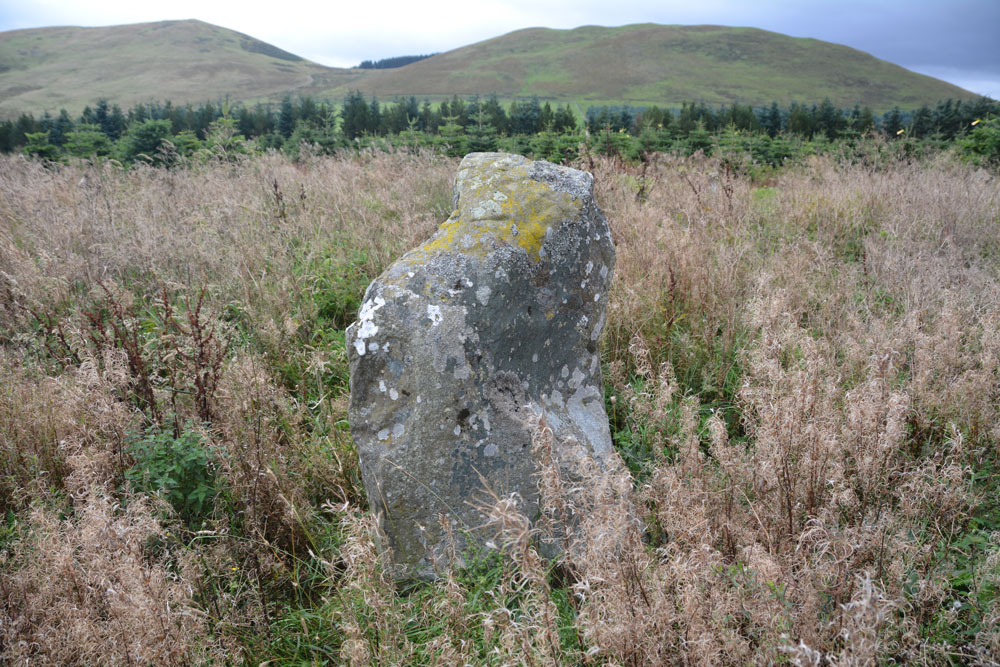
Moor Head (Brundean Laws) submitted by Anne T on 3rd Oct 2017. Looking east across the top of the taller stone, showing it's irregular shaped top.
(View photo, vote or add a comment)
Log Text: Moor Head (Brundean Laws), Scottish Border: This was our first stop on our journey to Armadale, and a part of the world we’ve been to before on a walk up Dere Street, but not stopped at these stones before. We parked at Brundean Laws farm entrance at NT 71651 11987 and walked up the track past the first few houses, to where the track divides at NT 72183 11509 just before Brundean Laws Farm, taking the right hand fork as we faced the main farmhouse. The area where the standing stones are has not been mowed, so stands out as a taller circle of grass around a telegraph pole at the south eastern end of the large field in which the stones stand.
We followed the track that heads of westwards until we were level with the stones, then headed the 30 metres or so to unmown area in which they stood. There is one main stone which is clearly a standing stone, with a second recumbent stone to its south east. A second, broken, stone pokes up out of a mound of smaller stones, which I thought was a quarried stone which had just been dumped, but checking with the Canmore record, this is the second standing stone. With the tall grass and thistles around the stones, it was difficult to tell if there were any more stones undergoot.
The stones do stand on a slight mound (although Canmore says they are 170 metres SSW of Moor Head summit) and if the Christmas tree forest hadn’t been to it’s north, west and south, would have had a commanding view over the surrounding hills which towered above this spot.
Tullie House Museum
Trip No.46 Entry No.1 Date Added: 19th Sep 2017
Site Type: Museum
Country: England (Cumbria)
Visited: Yes on 18th Sep 2017. My rating: Condition 4 Ambience 2 Access 4
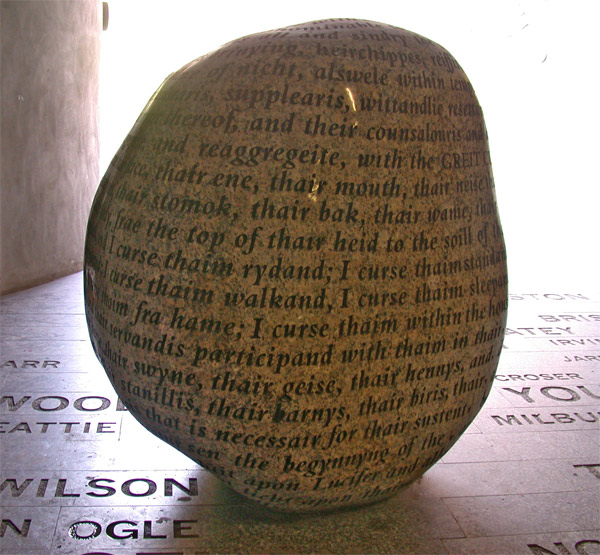
Tullie House Museum submitted by nicoladidsbury on 13th Mar 2005. Cursing Stone, Tullie House Millenium Walkway, Carlisle
The polished granite stone is inscribed with the curse, which was cast on all the reivers of the English/Scottish borders in the 16th Centuary.
The names of those reivers are inscribed in the stones that make up the floor of the millenium walkway, Armstrongs, Grahams, Robsons, Elliotts, and Kerrs to made a few.
The Tullie House Museum has a 10-minute wide-screen audio-visual spectacular which gives a dramatic impression of the lawles...
(View photo, vote or add a comment)
Log Text: The Cursing Stone, Carlisle: This stone is located in the strangely lit underpath that runs the dual carriageway near Tullie House Museum and Carlisle Castle, next to Tullie House museum. We came across this quite by chance, thinking it was located inside the museum. It is actually on the Tullie House side of the pedestrian underpass from the Castle to the Museum.
There is nothing on the walls of the underpass to tell you what this stone is. I’d read about it on the Portal some time ago and recognised it. The wording of the curse is recorded below.
St Mary's Old Church (Brignall)
Trip No.44 Entry No.4 Date Added: 15th Sep 2017
Site Type: Ancient Cross
Country: England (County Durham)
Visited: Yes on 9th Sep 2017. My rating: Condition 2 Ambience 4 Access 4
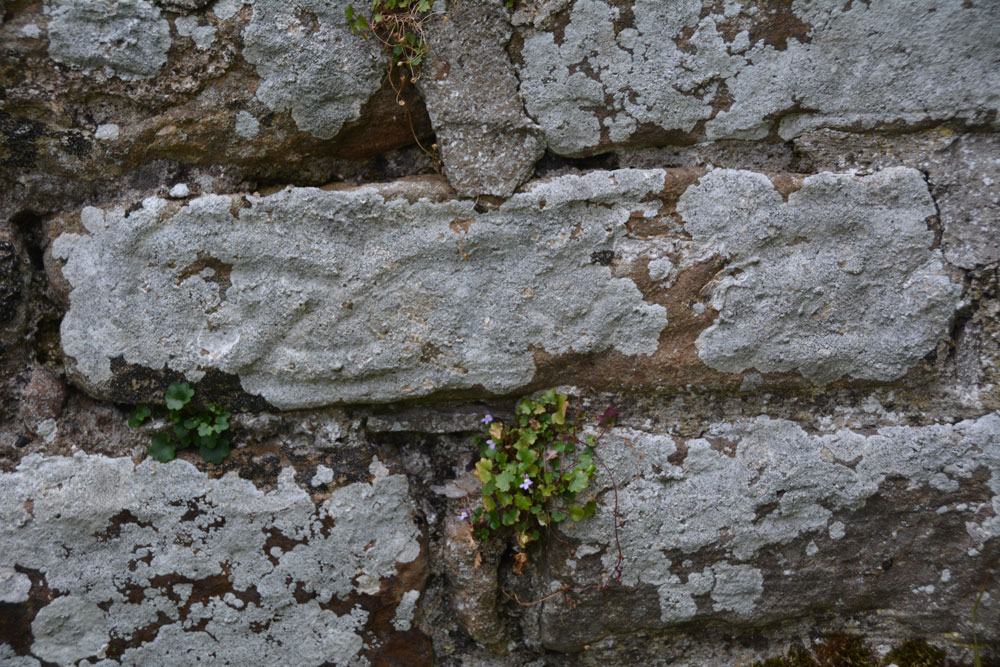
St Mary's Old Church (Brignall) submitted by Anne T on 11th Sep 2017. The interlacing can be seen on this piece of 9th century cross shaft, built into the north wall on the west side of the opening in the wall.
(View photo, vote or add a comment)
Log Text: 9th century cross shaft, St. Mary's Old Church, Brignall: Deserted Medieval Village: After not being able to find the cross base in ‘New St. Mary’s Church’, we left the car parked in front of the church and took the footpath to ‘The Old Church’ between the south wall of the churchyard and the neighbouring house. This quickly took us down an overgrown lane, following a small stream in a deep gulley to our left hand side. As the crow flies, it’s only 500 metres from the ‘new church’ to the ‘old church’, although it felt a lot longer.
Where the trees started to clear, with fields to our right, the path turned back on itself, seeming to lead straight down the gully to our stream. There was no signpost to say where the old church was, so we took the path leading downwards (to our left), at one point walking between two streams, and came out into a meadow. In the distance was the ruins of a small buildings surrounded by a low stone wall. It looked more like a tumbled down small farm house, but as we got nearer, the grave stones appeared above the wall line.
The gate had been firmly locked with a bolt and nuts, so we used the stile over the wall, descending into brambles and nettles. Other people had obviously walked this way as there were traces of indistinct tracks leading in various directions across the churchyard.
Making our way over to the building, we couldn’t see the piece of cross shaft, so I called the image up on my phone, having to hold it high up above my head to get a better signal! Almost immediately, I spotted it – to the left hand side of the opening in the wall (north), a few layers up from the current ground level.
The Historic England entry also said that there were re-used cross slabs over the east window and the now re-filled smaller windows in the east wall. On closer inspection, these looked like re-used grave slabs.
It wasn’t until we left the grounds of the church and followed a line of boulders leading down to what we thought was a stream, that we found out the River Greta ran just to the east of the church. The rig and furrow ploughing across the field was really obvious and it may be the stones marked the line of a crossing through the river? The Historic England entry also says the site has been painted by Turner and others.
St. Mary's Church (Brignall)
Trip No.44 Entry No.3 Date Added: 15th Sep 2017
Site Type: Ancient Cross
Country: England (County Durham)
Visited: Yes on 9th Sep 2017. My rating: Condition 3 Ambience 2 Access 5
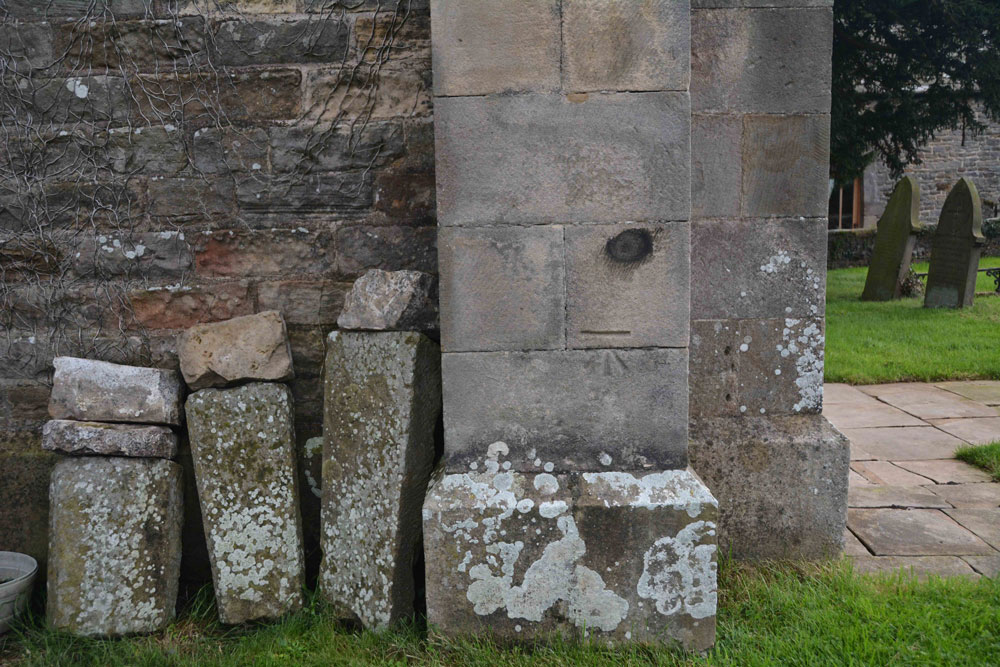
St. Mary's Church (Brignall) submitted by Anne T on 11th Sep 2017. The remains of a cross base, together with a Roman altar, are said to stand against the south wall of the church outside its west end.
This was the only collection of stones we could find on or near the church walls, and these sit against the north western corner of the tower.
(View photo, vote or add a comment)
Log Text: Cross base at St. Mary's New Church, Brignall (not found): After having visited the church in Barnard Castle and Barnard Castle, we set of to Brignall. According to Pastscape, there was a 13th century cross base sitting against the south-west corner of the tower of this church, together with a Roman altar and other stones. These used to be in the rectory gardens, but were re-sited in the churchyard.
No sign of the cross base or the altar existed, unless they are in this collection of stones, all of which are badly worn. These are located against the north west corner of the tower, behind the war memorial. There was nothing against the south west corner/south west wall of the church – I walked right round in case we’d missed anything, or they had been moved.
The church was locked at the time of our visit, so I couldn’t get inside to check if these artefacts had been moved inside for safety. As we parked up, a man in the house next to the church (to its right as photographed) was standing at the window looking at us, talking on the phone. He made no move to come out and talk to us, and made me feel like an intruder.
I will need to phone the Diocesan office to find out when the church is open and if the base and altar have been moved inside the church.
Christening Stone (Cotherstone)
Trip No.44 Entry No.1 Date Added: 15th Sep 2017
Site Type: Ancient Cross
Country: England (County Durham)
Visited: Yes on 9th Sep 2017. My rating: Condition 3 Ambience 3 Access 5
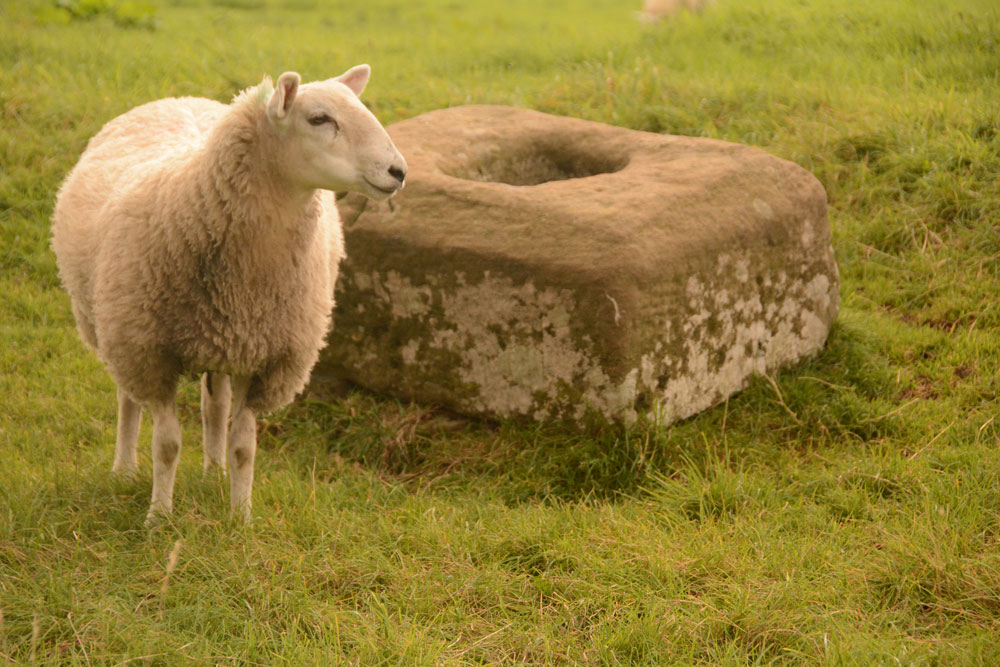
Christening Stone (Cotherstone) submitted by Anne T on 10th Sep 2017. First view of The Christening Stone from over the stone wall alongside Spout Bank (B6277), 160 metres south east of Doe Park Caravan Park.
(View photo, vote or add a comment)
Log Text: The Christening Stone, Cotherstone: This was our first stop of the day. Travelling south on the A68, the shortest route was cross-country through Hamsterley, driving along the B6278 Folly Bank into Eggleston, then turning onto the B6277 through Romaldkirk. The cross base is in a field to the right hand side of the road, 160 metres south of Doe Park caravan park, on Spout Bank.
The road is busy and narrow, but we managed to pull off into a double gateway at the side of the road and cross over to peer at the cross base. A sheep was huddled up to it when I first saw the base. The sheep then stood up once it noticed me and stood by the cross base, as if it was showing it off.
The cross looks as if it was sitting by the side of a hollow way, although now on a slope where the land dips towards the road. It looks quite crisply carved still. Although there was no gateway into the field, the stone wall was really low in places, and Andrew hopped over the wall to take a quick photograph of the western side of the base.
Pastscape says the base is Grade II listed and is in its original position on the medieval route between Cotherstone and Romaldkirk. Called The Christening Stone, a calf was christened at this cross as part of the May Day celebrations.
Hethpool Cairn
Trip No.45 Entry No.7 Date Added: 15th Sep 2017
Site Type: Cairn
Country: England (Northumberland)
Visited: Yes on 12th Sep 2017. My rating: Condition 2 Ambience 4 Access 5
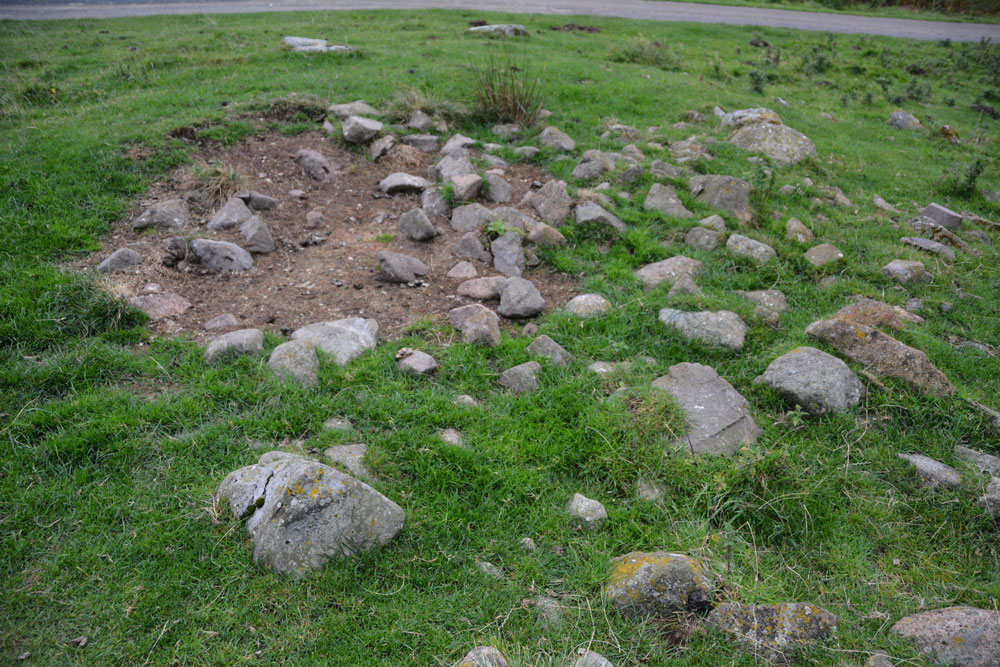
Hethpool Cairn submitted by Anne T on 13th Sep 2017. The Hethpool Cairn, showing its probably robbed centre.
(View photo, vote or add a comment)
Log Text: Hethpool Cairn, College Valley: By this time, it was getting reasonably late in the afternoon, and there was a definite chill in the air. After having been out a lot earlier than our normal setting off time, it seemed way past tea-time. Just as we were approaching Hethpool Stone circles, we both noticed a stony mound to the left hand side of the road, tucked between the road and a narrow band of forest that separates it from the stone circles.
OK, this could be just a dump of stones by the roadside, but I photographed it anyway, enjoying the view south down the valley before we set off for home. Opening up Pastscape later that evening, I was pleased to find this cairn recorded.
Southernknowe Farmstead (College Valley)
Trip No.45 Entry No.5 Date Added: 15th Sep 2017
Site Type: Ancient Village or Settlement
Country: England (Northumberland)
Visited: Yes on 12th Sep 2017. My rating: Condition 2 Ambience 3 Access 4
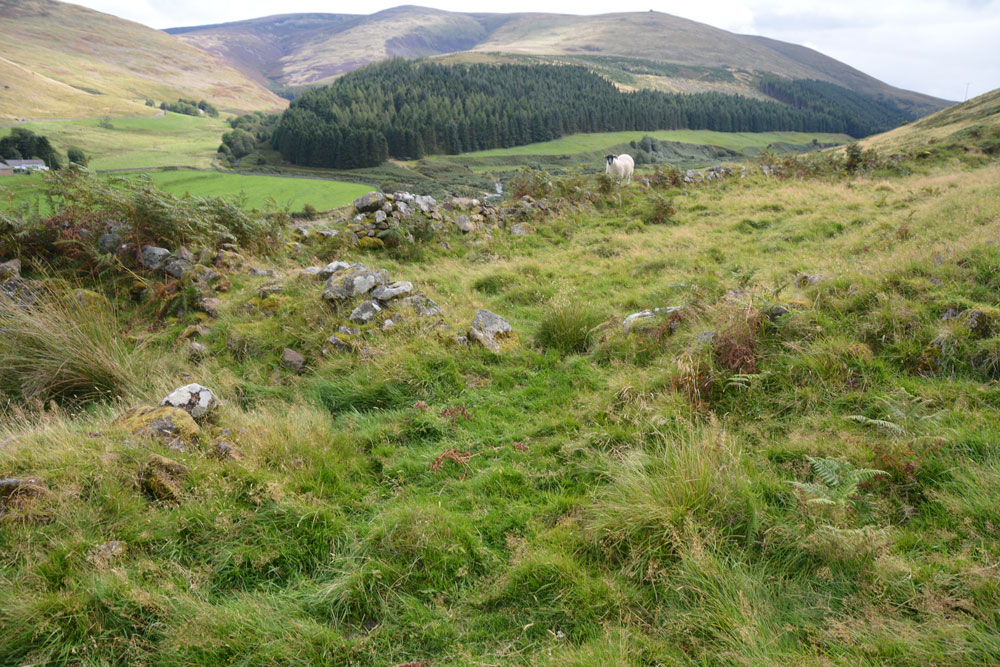
Southernknowe Farmstead (College Valley) submitted by Anne T on 15th Sep 2017. Standing almost at the sheepfold at the northern end of the farmstead, looking back down to College Burn (near where it meets Lambden Burn).
(View photo, vote or add a comment)
Log Text: Southernknowe Enclosed Farmstead, College Valley: This settlement sits high up the eastern slopes of Blackhaggs Riggs, almost opposite where Lambden Burn meets College Burn. Whilst we could see the stone walls/banks of this settlement from below, it was quite a hike up the steep slopes of the hill. Long and narrow, the inhabitants would have had a great view of any other people coming for miles. It is also very scenic, overlooking the meeting of Lambden Burn and College Burn. The river terraces in the valley below can be seen and it’s intriguing how the rivers have moved over the years.
Mounthooly (College Valley)
Trip No.45 Entry No.6 Date Added: 15th Sep 2017
Site Type: Ancient Village or Settlement
Country: England (Northumberland)
Visited: Yes on 12th Sep 2017. My rating: Condition 2 Ambience 4 Access 4

Mounthooly (College Valley) submitted by Anne T on 15th Sep 2017. First view of the Mounthooly Romano-British Enclosed Scooped Settlement from the sheep pens by the footpath.
(View photo, vote or add a comment)
Log Text: Mounthooly Enclosed Scooped Settlement, College Valley: We drove down the road as far as we could go, nearly at Mounthooly Farm and International Hostelry, and there was a big sign saying ‘no cars past this point’. There were two other cars parked on the grass verge, but no signs of other people.
The road had been gated at Fleehope farm, where they were taking out the whole of the forest by Fleehope Burn, to the west of the farmhouse, and there were huge piles of logs and heavy machinery. Whoever had parked the Land Rover on about a 45 degree slope near the forest had to be congratulated for an epic display of 4 wheel driving!
We walked along the track past Mounthooly Farm and the Hostelry (which has a clean toilet block!), past the narrow strip of forest and found the footpath making its way through the sheep pens, through the field, by a hide. Immediately after coming through the sheep folds, the scoop of the settlement came into view.
Standing towards the western end of the settlement, the scoop is cut deep into the hillside and it seemed to loom around 5+ metres above me, although both Pastscape and Historic England say it’s only 3 metres.
The farmer has been using this area as a dump, and there were no end of empty plastic feed supplement bags and bottles.
There was a clear, wide ditch to the west and south of the settlement; it’s northern end had been cut by the forestry plantation and fence.
My eye was drawn across to the eastern side of College Burn, and a large light coloured boulder. When we got home, it turned out that there was another larger settlement, field systems and cairnfields to the east of the burn. There was also another settlement to the south east of the field, but there was a very large herd of bullocks gathered, so we opted out on this occasion.
What a fascinating area. Needs much more investigation.
Dunsdale (College Valley)
Trip No.45 Entry No.4 Date Added: 14th Sep 2017
Site Type: Ancient Village or Settlement
Country: England (Northumberland)
Visited: Yes on 12th Sep 2017. My rating: Condition 1 Ambience 4 Access 5
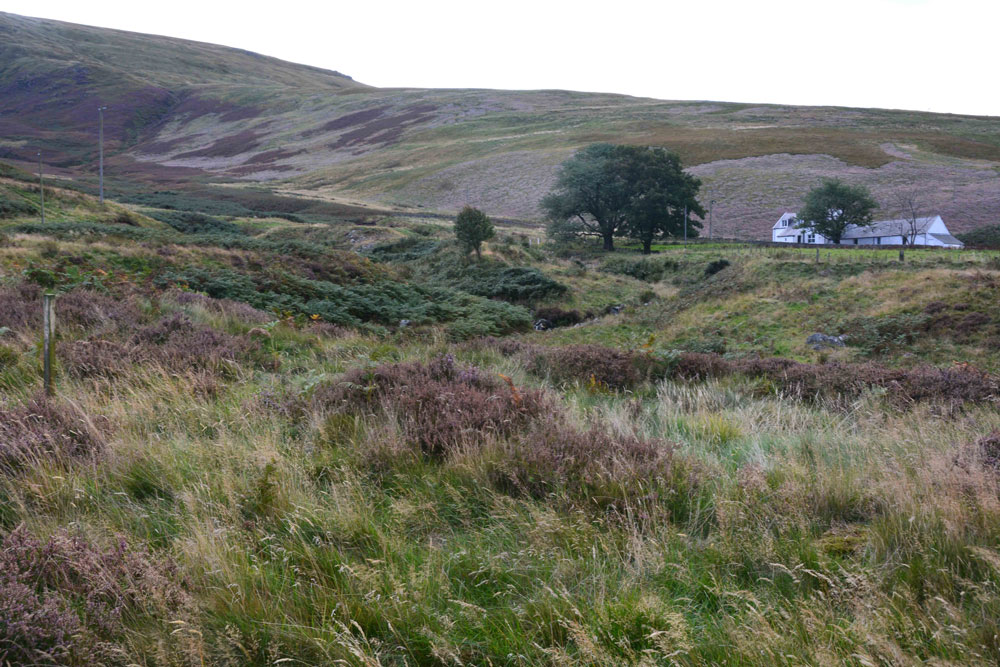
Dunsdale (College Valley) submitted by Anne T on 14th Sep 2017. Standing in the middle of the settlement (largely buried underneath bracken) looking over Bizzle Burn towards Dunsdale Farm
(View photo, vote or add a comment)
Log Text: Dunsdale Settlement, College Valley: Wow. The screen slopes to the north of this path are daunting and impressive at the same time. If there was a landslip here, you might be cut off for some time.
The settlement here was difficult to make out because of the very tall grass and heather, but we could feel stone foundations under our feet and depressions in the ground.
It is a very beautiful spot, with the scree slopes of Dunsdale Crag to the north and Bizzle Burn running to the west of this site.
Would really like to come back here in winter to see more of the site structure.
Coldburn (College Valley)
Trip No.45 Entry No.3 Date Added: 14th Sep 2017
Site Type: Ancient Village or Settlement
Country: England (Northumberland)
Visited: Yes on 12th Sep 2017. My rating: Condition 2 Ambience 4 Access 4

Coldburn (College Valley) submitted by Anne T on 14th Sep 2017. Having clambered up the steep(ish) hillside until the land levelled off, this is our first glimpse of the Coldburn Settlement from the north west.
(View photo, vote or add a comment)
Log Text: Coldburn Settlement (College Valley): After visiting the Southernknowe Settlement, the road splits into two. We took the eastern road at this point, travelling over Sutherland Bridge. There is a sign which says to beware as the road is not in very good condition, which is right! It is very narrow and has great potholes in parts.
We managed to pull off the road where a small layby had been created with lots of broken tarmac and stones. From this point, to the west of the settlement, we clambered up the somewhat steep-ish hillside, to where the land levelled off. Heading east, the scoop of the settlement came into view.
There are no obvious internal features within this settlement, but there are certainly views in three directions, with the steep slope of Coldburn Hill on the fourth.
The scoop is deepest to the north of the oval, and there appears to be two terraces cut into the hillside above.
Once in the settlement, we discovered a track cut into the bank of the settlement leading down to Coldburn Farm, so there was a much easier way of accessing this site!
Southernknowe (College Valley)
Trip No.45 Entry No.2 Date Added: 14th Sep 2017
Site Type: Ancient Village or Settlement
Country: England (Northumberland)
Visited: Yes on 12th Sep 2017. My rating: Condition 2 Ambience 4 Access 5
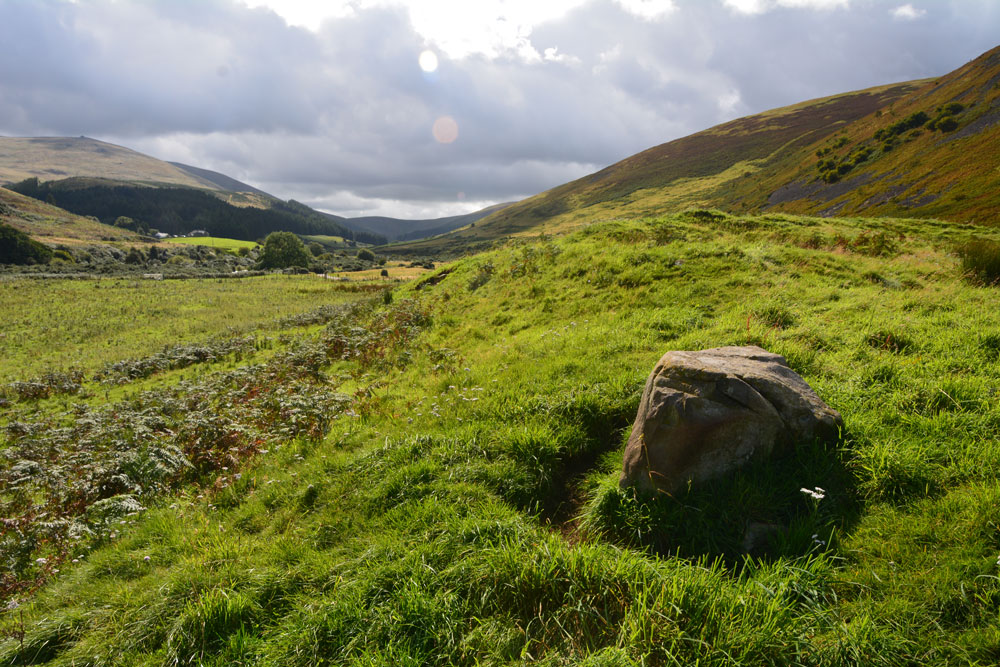
Southernknowe (College Valley) submitted by Anne T on 14th Sep 2017. Standing along the south eastern bank of the settlement, with College Burn to the right hand side in the dip. This large boulder rises up out of the bank. Beyond it, just down the slope, erosion has exposed boulder clay. At this point, the bank is steepest and looks like the settlement has been built on an old river terrace.
(View photo, vote or add a comment)
Log Text: Southernknowe RB Settlement, College Valley: Never having been down so far south in College Valley before, I was fascinated by how beautiful the scenery was, and how many people live here. We saw the sign posts for ‘Wedding This Way’ from Hethpool onwards, and came to the tiny, very white Cuddystone Hall, tucked just behind a small wooded area. Parking on the grassy area with a couple of other cars just north of the hall, we took up the invitation on the College Valley History web page to explore the earthwork remains of the settlement ‘dating from the Roman Iron Age times.’
Just before the road junction and the Airmen’s Memorial (Cheviot Memorial) there is a gate into the field. Letting ourselves in, we wandered round and through this scooped settlement nestled on the west bank of the College Burn, with its scooped hut circles and courtyards. The hut circles were more obvious in the northern (smaller) courtyard. The bank to the south eastern side was steep, dropping down to College Burn. Just past a large boulder on the south eastern bank, erosion left boulder clay clearly visible.
On the hillside to the south west there is another enclosure marked on the OS map, higher up the slopes of Blackhaggs Rigg. We planned to call back here later in the day.
Hethpool Stone Circles
Trip No.45 Entry No.1 Date Added: 14th Sep 2017
Site Type: Stone Circle
Country: England (Northumberland)
Visited: Yes on 12th Sep 2017. My rating: Condition 3 Ambience 5 Access 5
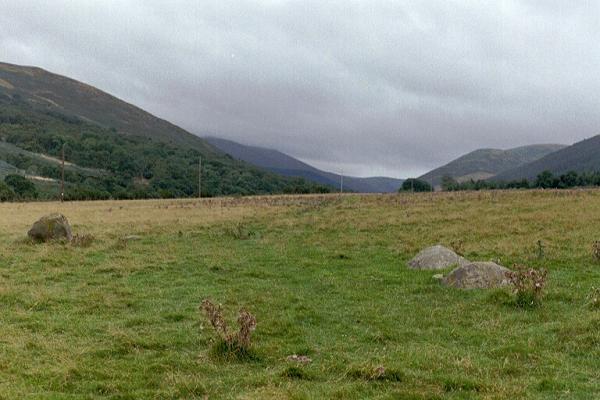
Hethpool Stone Circles submitted by Andy B on 27th Feb 2003. Part of the Burnham family trip to Northumberland, August 2002
(View photo, vote or add a comment)
Log Text: Hethpool Stone Circles, College Valley: We needed to be up really early this morning, but completed what we needed to do by 9am. As there were high winds and rain forecast for this evening/tonight and for the next few days, husband suggested we make the most of the good weather and go up to College Valley. He organised a pass from Saville’s in Wooler (we were one of 8 cars today – usually there are only 1 or 2 the receptionist said).
The last time we were here was over 15 years ago, in the days when I didn’t have a camera, and whilst we saw the stone circle and Little Heatha Fort, didn’t have any evidence of our trip.
Considering this is marked on the map as a (singular) stone circle, it immediately looked (to me) as if there two side-by-side circles – the stones weren’t in one simple circle and they were too widespread. We climbed up to the telegraph pole up the hill to try and get a better look at the circle, but it was still too spread out (and many of the stones too low to the ground) to photograph well.
Given that the small car park at the entrance to the valley was pretty full, and we saw long crocodiles of walkers, we seemed to be the only people interested in the stone circle, which was surprising.
The Butter Stone
Trip No.44 Entry No.2 Date Added: 10th Sep 2017
Site Type: Standing Stone (Menhir)
Country: England (County Durham)
Visited: Yes on 9th Sep 2017. My rating: Condition 3 Ambience 3 Access 4
The Butter Stone submitted by durhamnature on 16th Jul 2012. The Butter Stone, the hills of Teesdale in the background.
Site in County Durham England
(View photo, vote or add a comment)
Log Text: The Butter Stone, Cotherstone: From the cross base, we continued along the B6277, turning onto the minor road from Cotherstone towards the Battle Hill Ranges. We hadn’t expected to turn from pasture and woodland almost straight onto a moorland road.
From the turning in Cotherstone to the Butter Stone is almost 1.7km. Just passing a farm entrance to the east of the road, the stone is almost immediately to the west, about 25 metres from the side of the road. A narrow grassy footpath leads from the road to the stone, which appears to be a well eroded natural erratic. It just about shows above the tussocky grass around it.
A old penny had been glued into a hollow in the top of the stone, and in the other hollows around the outside of the stone there were 20 pence pieces slotted into them.
I was surprised to find this stone was used as an exchange/boundary point during the 17th century plague, and it is sited just below the brow of the hill.
Haining House (Lambley)
Trip No.43 Entry No.2 Date Added: 5th Sep 2017
Site Type: Cairn
Country: England (Northumberland)
Visited: Yes on 2nd Sep 2017. My rating: Condition 3 Ambience 4 Access 4
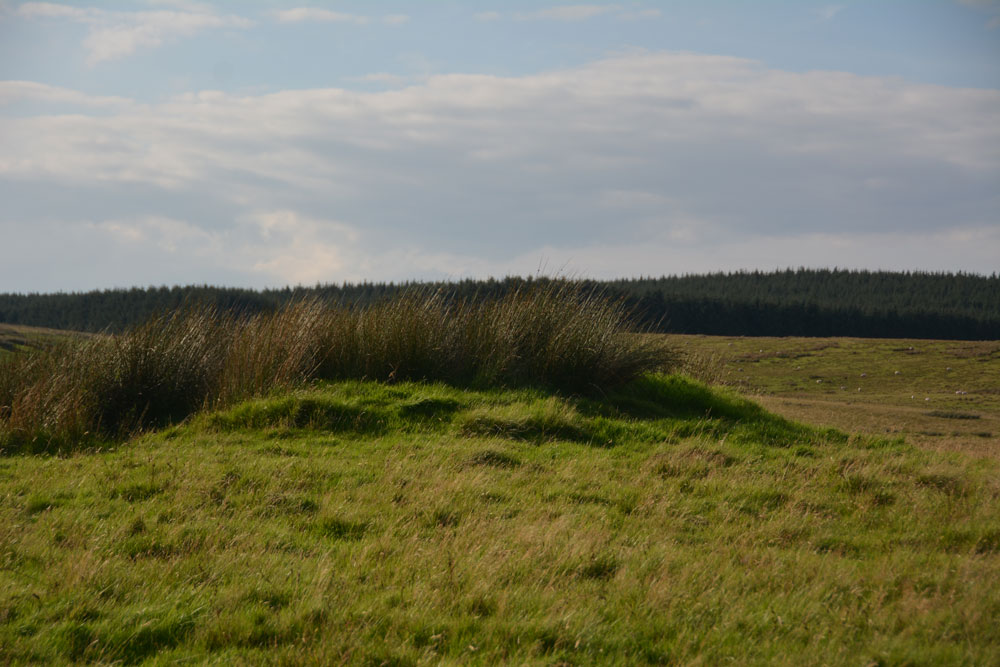
Haining House (Lambley) submitted by Anne T on 5th Sep 2017. First view of the cairn, peeking northwards over the stone wall which runs parallel with the track leading up to Haining House on Hartleyburn Common.
(View photo, vote or add a comment)
Log Text: Haining House Cairn, Hartleyburn Common: It was difficult to park here, as the road was so narrow. In the end we managed to bump the car up a slight bank to the north east of the track to Haining House. The track to the farm house was well looked after, although to drive to it, you’d have had to opened (and shut) three gates.
The cairn was easily identify-able, and being on access land, we walked to the gate located in the stone wall just to the west of the cairn, and walked back. There are some curiously deeply cut valleys to the north west of this cairn, now in a u-shaped feature. There are some cup and ring marked rocks along this section of the burn, although we planned to walk further west to see some more settlements this afternoon.
However, leaving the cairn and letting ourselves into a field with a gate, the heads of some very curious, and large, cattle/bullocks appeared above a slight mound. We retreated and went to look at the map for some other sites to see.
Coanwood (Lambley)
Trip No.43 Entry No.1 Date Added: 5th Sep 2017
Site Type: Ancient Village or Settlement
Country: England (Northumberland)
Visited: Yes on 2nd Sep 2017. My rating: Condition 3 Ambience 3 Access 5

Coanwood (Lambley) submitted by Anne T on 5th Sep 2017. The eastern bank of the enclosure as it runs south along the fence line inside the field.
(View photo, vote or add a comment)
Log Text: Coanwood Settlement, Lambley: Driving from the Diamond Oak and the World War II prisoner of war camp to the north, this settlement lies immediately opposite the junction of the 68 Cycle Route and the A689 at Lambley. It lies very near the Roman route of Maiden Way, which in this part of the world goes over Hartleyburn Fell and Glendue Fell, and runs west of this settlement, following the route of the Pennine Way through Lambley Common.
We decided, on impulse, to stop and have a look, especially as there was a handy hard-cored parking space next to the green pumping station and were so interested, I did something I don’t usually do, and let myself into the field to walk along the track running parallel with the southern bank.
I could make out a rectangular structure in the south eastern corner, and possible hut circle mid-way across and one-third of the length south of the northern bank.
Housesteads Tumulus
Trip No.43 Entry No.3 Date Added: 4th Sep 2017
Site Type: Artificial Mound
Country: England (Northumberland)
Visited: Yes on 2nd Sep 2017. My rating: Condition 2 Ambience 2 Access 5
Housesteads Tumulus submitted by SolarMegalith on 21st Jul 2016. The mound seen from the S-SE (photo taken on July 2016).
(View photo, vote or add a comment)
Log Text: Housesteads Tumulus, Northumberland: From photographing the remains of Triermain Castle and after having failed to see several sites today because of Boisterous Bullocks or lack of parking reasonably near the well, I wasn’t in the frame of mind to go straight home. As we were very near the B6318, I asked to go back that way to see ‘Solarmegaliths Mound’ opposite Housesteads. I hadn’t realised until I looked closely that this is marked on the OS Map.
By this time it was 7pm and the car park was empty apart from one car and a very large campervan. I confess that every time we’ve driven past this site, I thought how unsightly this ‘farmer’s dump’ was in the corner of the field. It was only when Cezary told me on one of the archaeological field days that he’d stopped off to see this site, that I promised myself one day I’d stop off and look for myself.
As a mound, it is a little non-descript, but having crossed the road from Housesteads car park, we let ourselves into the field (knot untying skills came in useful again) and walked round. The whole area around the base of the tumulus has been used as a dump and there is rubbish and fence posts around much of it.
Also marked on the OS map is a mound, further south and we walked further into the field (ducking from the farmer's trucks with trailers behind them, in case we got caught!).
Having walked back to the car park, we noticed a sign saying there had been an application made for number plate recognition for car park charging. We looked around for cameras, but couldn’t see any. If a parking charge notice comes through the door in the next few weeks, I will be cross.
